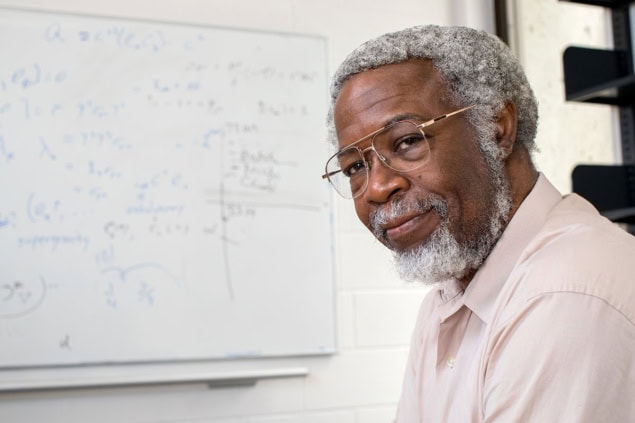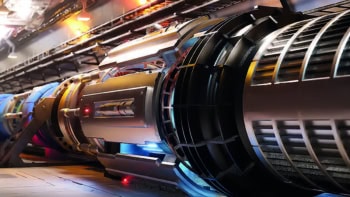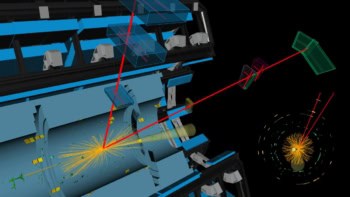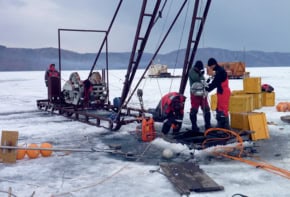Jim Gates talks to Margaret Harris about the discoveries he can tick off his “theorist’s bucket list”, adds some new ones, and delves into the state of science and society in the US today

In 2014 the American mathematical physicist S James Gates Jr shared his “theorist’s bucket list” of physics discoveries he would like to see happen before, as he puts it, he “shuffles off this mortal coil”. A decade later, Physics World’s Margaret Harris caught up once more with Gates, who is now at the University of Maryland, US, to see what discoveries he can check off his list; what he would still like to see discovered, proven or explored; and what more he might add to the list, as of 2025.
The first thing on your list 10 years ago was the discovery of the Higgs boson, which had happened. The next thing on your list was gravitational waves.
The initial successful detection of gravity waves [in 2015] was a spectacular day for a lot of us. I had been following the development of that detector [the Laser Interferometer Gravitational-wave Observatory, or LIGO] almost from its birth. The first time I heard about detecting gravity waves was around 1985. I was a new associate professor at Maryland, and a gentleman by the name of [Richard] Rick Isaacson, who was a programme officer at the National Science Foundation (NSF), called me one day into his office to show me a proposal from a Caltech-MIT collaboration to fund a detector. I read it and I said this will never work. Fortunately, Isaacson is a superhero and made this happen because for decades he was the person in the NSF with the faith that this could happen; so when it did, it was just an amazing day.
Why is the discovery of these gravitational waves so exciting for physicists?
Albert Einstein’s final big prediction was that there would be observable gravitational waves in the universe. It’s very funny – if you go back into the literature, he first says yes this is possible, but at some point he changes his mind again. It’s very interesting to think about how human it is to bounce back and forth, and then to have Mother Nature say look, you got it right the first time. So such a sharp confirmation of the theory of general relativity was unlike anything I could imagine happening in my lifetime, quite frankly, even though it was on my bucket list.
The other thing is that our species knows about the heavens mostly because there have been “entities” that are similar to Mercury, the Greek god who carried messages from Mount Olympus. In our version of the story, Mercury is replaced by photons. It’s light that has been telling us for hundreds of thousands of years, maybe a million years, that there’s something out there and this drove the development of science for several hundred years. With the detection of gravitational waves, there’s a new kid on the block to deliver the message, and that’s the graviton. Just like light, it has both particle and wave aspects, so now we have detected gravitational waves, the next big thing is to be able to detect gravitons.
We are not completely clear on exactly how to see gravitons, but once we have that knowledge, we will be able to do something that we’ve never been able to do as a species in this universe. After the initial moments of the Big Bang, there was a period of darkness, when matter was far too hot to form neutral atoms, and light could not travel through the dense plasma. It took 380,000 years for electrons to be trapped in orbits around nuclei, forming the first atoms.
Eventually, the universe had expanded so much that the average temperature and density of particles had dropped enough for light to travel. Now what’s really interesting is if you look at the universe via photons, you can only look so far back up to that point when light was first able to travel through the universe, often referred to as the “first dawn”. We detected this light in the 1960s, and it’s called the cosmic microwave background. If you want to peer further back in time beyond this period, you can’t use light but you can use gravitational waves. We will be able as a species eventually to look maybe all the way back to the Big Bang, and that’s remarkable.
What’s the path to seeing gravitons experimentally?
At the time that gravitational waves were detected by LIGO there were three different detectors, two in the US and one on the border of France and Italy called Virgo. There is a new LIGO site coming online in India now, and so what’s going to happen, provided there continues to be a global consensus on continuing to do this science, is that more sites like this are going to come online, which will give us higher-fidelity pictures. It’s going to be a difference akin to going from black and white TV to colour.

In the universe now, the pathway to detecting gravitons involves two steps. First, you probably want to measure the polarization of gravitons, and Fabry–Pérot interferometers, such as LIGO, have that capacity. If it’s a polarized graviton wave, the bending of space-time has a certain signature, whether it’s left or right-handed. If we are lucky enough we will actually see that polarization, I would guess within the next 10 years.
The second step is quantization, which is going to be a challenge. Back in the 1960s a physicist at the University of Maryland named Joseph Weber developed what are now called Weber bars. They’re big metal bars and the idea was you cool them down and then if a graviton impinges on these bars, it would induce lattice vibrations in the metal, and you would detect those. I suspect there’s going to be a big push in going back and upgrading that technology. One of the most exciting things about that is they might be quantum Weber bars. That’s the road that I could see to actually nailing down the existence of the graviton.
Number three on your bucket list from a decade ago was supersymmetry. How have its prospects developed in the past 10 years?
At the end of the Second World War, in an address to the Japanese people after the atomic bombing of Hiroshima and Nagasaki, the Japanese emperor [known as Showa in Japan, Hirohito in the West] used the phrase “The situation has developed not necessarily to our advantage”, and I believe we can apply that to supersymmetry. In 2006 I published a paper where I said explicitly I did not expect the Large Hadron Collider (LHC) to detect supersymmetry. It was a back-of-the-envelope calculation, where I was looking at the issue of anomalous magnetic moments. Because the magnetic moments can be sensitive to particles you can’t actually detect, by looking at the anomalous magnetic moment and then comparing the measured value to what is predicted by all the particles that you know, you can put lower bounds on the particles that you don’t know, and that’s what I did to come up with this number.
It looked to me like the lightest “superpartner” was probably going to be in the range of 30 Tev. The LHC’s initial operations were at 7 TeV and it’s currently at 14 TeV, so I’m feeling comfortable about this issue. If it’s not found by the time we reach 100 Tev, well, I’m likely going to kick the bucket by the time we get that technology. But I am confident that SUSY is out there in nature for reasons of quantum stability.
Also, observations of particle physics – particularly high-precision observations, magnetic moments, branching ratios, decay rates – are not the only way to think about finding supersymmetry. In particular, one could imagine that within string theory, there might be cosmological implications (arXiv:1907.05829), which are mostly limited to the question of dark matter and dark energy. When it comes to the dark-matter contribution in the universe, if you look at the mathematics of supersymmetry, you can easily find that there are particles that we haven’t observed yet and these might be the lightest supersymmetric particle.
And the final thing in your bucket list, which you’ve touched on, was superstring theory. When we last spoke, you said that you did not expect to see it. How has that changed, if at all?
Unless I’m blessed with a life as long as Methuselah, I don’t expect to see that. I think that for superstring theory to win observational acceptance, it will likely come about not from a single experiment, but from a confluence of observations of the cosmology and astrophysics type, and maybe then the lightest super symmetric particle will be found. By the way, I don’t expect extra dimensions ever to be found. But if I did have several hundred years to live, those are the kinds of likely expectations I would have.
And have you added anything new to your bucket list over the past 10 years?
Yes, but I don’t quite know how to verbalize it. It has to do with a confluence of things around quantum mechanics and information. In my own research, one of the striking things about the graphs that we developed to understand the representation theory of supersymmetry –we call them “adinkras” – is that error-correcting codes are part of these constructs. In fact, for me this is the proudest piece of research I’ve ever enabled – to discover a kind of physics law, or at least the possibility of a physics law, that includes error-correcting codes. I know of no previous example in history where a law of physics includes error-correcting codes, but we can clearly see it in the mathematics around these graphs (arXiv:1108.4124).

Symbols of power: how adinkras could lead to fresh insights into supersymmetry
That had a profound impact on the way I think about information theory. In the 1980s, John Wheeler came up with this very interesting way to think about quantum mechanics (“Information, physics, quantum: the search for links” Proc. 3rd Int. Symp. Foundations of Quantum Mechanics, Tokyo, 1989, pp354–368). A shorthand phrase to describe it is “it from bit” – meaning that the information that we see in the universe is somehow connected to bits. As a young person, I thought that was the craziest thing I had ever heard. But in my own research I saw that it’s possible for the laws of physics to contain bits in the form of error-correcting codes, so I had to then rethink my rejection of what I thought was a wild idea.
In fact, now that I’m old, I’ve concluded that if you do theoretical physics long enough, you too can become crazy – because that’s what sort of happened to me! In the mathematics of supersymmetry, there is no way to avoid the presence of error-correcting codes and therefore bits. And because of that my new item for the bucket list is an actual observational demonstration that the laws of quantum mechanics entail the use of information in bits.
In terms of when we might see that, it will be long after I’ve gone. Unless I somehow get another 150 years of life. Intellectually, that’s how long I would estimate it will take as of now, because the hints are so stark, they suggest something is definitely going on.
We’ve talked a little bit about how science has changed in the past 10 years. Of course, science is not unconnected with the rest of the world. There have been some changes in other things that impinge on science, particularly those recently developing in the US. What’s your take on that?
Unfortunately, it’s been very predictable. Two years ago I wrote an essay called “Expelled from the mountain top?” (Science 380 993). I took that title from a statement by Martin Luther King Jr where he says “I’ve been to the mountaintop”, and the part about being “expelled” refers to closing down opportunities for people of colour. In my essay I talked about the fact that it looked to me like the US was moving in a direction where it would be less likely that people like me – a man of colour, an African American, a scientist – would continue to have access to the kind of educational training that it takes to do this [science].
I’m still of the opinion that the 2023 decision the Supreme Court made [about affirmative action] doesn’t make sense. What it is saying is that diversity has no role in driving innovation. But there’s lots of evidence that that’s not right. How do you think cities came into existence? They are places where innovation occurs because you have diverse people coming to cities.
You add to that the presence of a new medium – the Internet – and the fact that with this new medium, anyone can reach millions of people. Why is this a little bit frightening? Well, fake news. Misinformation.

I ran into a philosopher about a year ago, and he made a statement that I found very profound. He said think of the printing press. It allowed books to disseminate through Western European society in a way that had never happened before, and therefore it drove literacy. How long did it take for literacy levels to increase? 50 to 100 years. Then he said, now let’s think about the Internet. What’s different about it? The difference is that anyone can say anything and reach millions of people. And so the challenge is how long it will take for our species to learn to write the Internet without misinformation or fake news. And if he’s right, that’s 100, 150 years. That’s part of the challenge that the US is facing. It’s not just a challenge for my country, but somehow it seems to be particularly critical in my country.
So what does this have to do with science? In 2005 I was invited to deliver a plenary address to the American Association for the Advancement of Science annual meeting. In that address, I made statements about science being turned off because it was clear to me, even back then in my country, that there were elements in our society that would be perfectly happy to deny evidence brought forth by scientists, and that these elements were becoming stronger.
You put this all together and it’s going to be an extraordinarily important, challenging time for the continuation of science because, certainly at the level of fundamental science, this is something that the public generally has to say “Yes, we want to invest in this”. If you have agencies and agents in society denying vaccines, for example, or denying the scientific evidence around evolution or climate change, if this is going to be something that the public buys into, then science itself potentially can be turned off, and that’s the thing I was warning about in 2005.
What are some practical things that members of the scientific community can do to help prevent that from happening?
First of all, come down from the ivory tower. I’ve been a part of some activities, and they normally are under the rubric of restoring the public’s trust in science, and I think that’s the wrong framing. It’s the public faith in science that’s under attack. So from my perspective, that’s what I’d much rather have people really thinking about.
What would you say the difference is between having trust in science and having faith in science?
In my mind, if I trust something, I will listen. If I have faith in something, I will listen and I will act. To me, this is a sharp distinction.
Personally, even though I expect that it’s going to be really hard going forward, I am hopeful. And I would urge young people never to lose that hope. If you lose hope, there is no hope. It’s just that simple. And so I am hopeful. Even though people may take my comments as “oh, he’s just depressed” – no, I’m not. Because I’m a scientist, I believe that one must, in a clear-eyed, hard-headed manner, look at the evidence that’s in front of us and not sentimentally try to dodge what you see, and that’s who I am. So I am hopeful in spite of all the things that I’ve just said to you.



